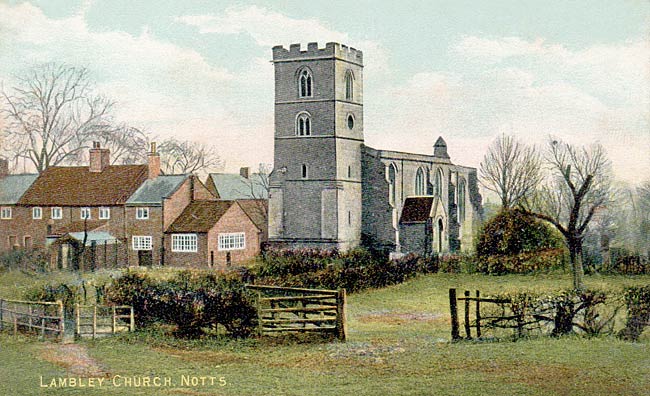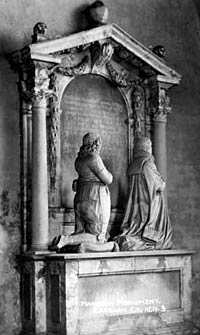< Previous | Contents | Next >
The First Budget
LAMBLEY. It lies in a hollow of the hills, one of a group of villages where the stocking frame once rattled all day long, with the home of its inventor not far away. It has long been loved for its pretty Dumbles, watered by the little Cocker Beck, but its lasting claim to remembrance is that it was the birthplace of a famous man.

Lambley church, c.1905.
Here for a time lived some of the old family of Cromwell, and here the great Ralph Lord Cromwell was born about 1394, perhaps in the manor house which stood where the rectory is now; we may still trace something of its moat. He was the last of ten generations to bear the name of Ralph, was a great statesman and financier, and as High Treasurer of England in 1433 may be said to have prepared our first Budget in his masterly statement of the national accounts.
One of the wealthiest nobles of his time, he was able to gratify his passion for building. He built himself a manor house at South Wingfield, Derbyshire, now a splendid ruin. He built the castle and enriched the church of Tattershall in Lincolnshire, where he lies. He left a lasting memorial in his birthplace, for he refashioned the beautiful church except for the tower and part of the chancel. His badge of office, a purse, is carved on stone panels by the east window outside, and worn stones in the chancel floor keep green the memory of his family.
Other old coffin stones are in the stone seats of the porch, and its inner walls (like other walls of the church) are scored with marks which seem to have been made by bowmen sharpening their arrows. Most of the tower is 13th century; the top is 14th, but the arch opening into the nave is Norman. The north wall of the chancel was built in 1340 when the sixth Ralph Cromwell founded a two-storeyed chantry here. It has gone, but there is still the peephole from its upper room.
We come into the chancel through an old oak screen which has been here since 1377; it rises 11 feet high, and over it hangs a great wooden Crucifix in memory of an old lady of Lambley who died at 95 during the war. The canopied pulpit is a thankoffering for peace and the parson enters it by the old winding stairway in the wall. The altar table is Jacobean, and there is Jacobean carving in the lectern, the reading desk, and the stalls. The font is 500 years old. The east window has fragments of ancient glass with a Crucifixion, a crowned Madonna, and a saint in blue and gold.
A Norman Door
LANEHAM. There is high tide and low tide at Laneham, though its fine reach of the Trent is miles from the sea.
What is known as Church Laneham nestles close to the bank, which is like a seaside beach when the tide is out, and always picturesque with pleasure boats, barges passing to and fro, and the ferryboat crossing to Lincolnshire. From the riverside we see Lincoln's tower when the day is clear, and a delightful picture of Laneham's farms gathered round an old church on a little knoll, all mantled in trees.

Laneham church in 1982.
Full of years and interest, the church stands where great chestnuts overhang the road. Its 13th century tower has an 11th century square-headed doorway, and a crude round arch of the same time in the walling above. There is early herringbone masonry in the walls, and a lovely Norman doorway through which we enter has two detached pillars on each side supporting an arch with a handsome array of zigzag enriched with sunflower pattern. Rarer still is the fine old door it frames, for it is one of the oldest in the land, one of the very few Norman doors we have opened and shut on our journeyings, perhaps a dozen in all England. As old as the doorway itself, its plain weatherworn boards are still good, and it is swinging today on the hinges made for it eight centuries ago.
The Norman chancel arch has a shaft on each side. Between the nave and its aisle is a beautiful 13th century arcade of three graceful bays: at the foot of one of the clustered pillars is a great stone seat, and the base of the other is continued to make two steps for the massive Norman font. Almost the only coloured glass in the medieval windows are 14th century fragments of amber and red, showing a crowned queen with a kneeling winged figure at her side.
The church has two old chests, one 16th century, another an exceptionally fine one of the 13th, bound with iron and adorned with roundels carved with sunflowers. Another rare possession of the 13th century are 14 sturdy seats of oak shaped with the adze, their plain ends chamfered at the top. One or two have restored seats, but the rest are entirely original and remarkable, for very few churches in England have any like them. Three are nearly 12 feet long and the others 8. The registers are another treasure, for they are continuous from 1538.
From the old pulpit here preached Samuel Slinn Skene while he was vicar from 1904 till 1919. He had the remarkable experience of living to see seven sons ordained in the ministry.

Markham monument, c.1920.
Kneeling on cushions on an elaborate 17th century monument in the chancel are Ellis Markham, a judge, and his son Jervase, a soldier who died in 1636. Both have lost their hands. The judge, with a beard and long hair, wears a ruff, a tunic, and a mantle trimmed with straps and buttons. Jervase is in armour; his hair curls on to his shoulders, and an extraordinary long plait from one side of his head is tucked under his sash. He is said to be the Markham Queen Elizabeth mentioned in the couplet:
Gervase the Gentle, Stanhope the Stout,
Markham the Lion, and Sutton the Lout.
A farmhouse on the river bank is on the site of their old home, but its cellars are said to have belonged to the still older palace of the Archbishops of York on this spot, in which Thomas de Corbridge died in 1304.
A good gift of this 20th century is the charming timbered porch which shelters the Norman doorway. It comes from a restoration which followed the 14th century design, and keeps the original timbered entrance arch to link the old with the new. It was the work of local craftsmen; the village joiner and bis son did the timbering, the village builder set up the stone and brick and tile work, and the rich bargeboard was carved in the Laneham joiner's shop, so that all the work was done in the village. The joiner's son who helped to build it was the first to be carried through the porch to his last rest.
